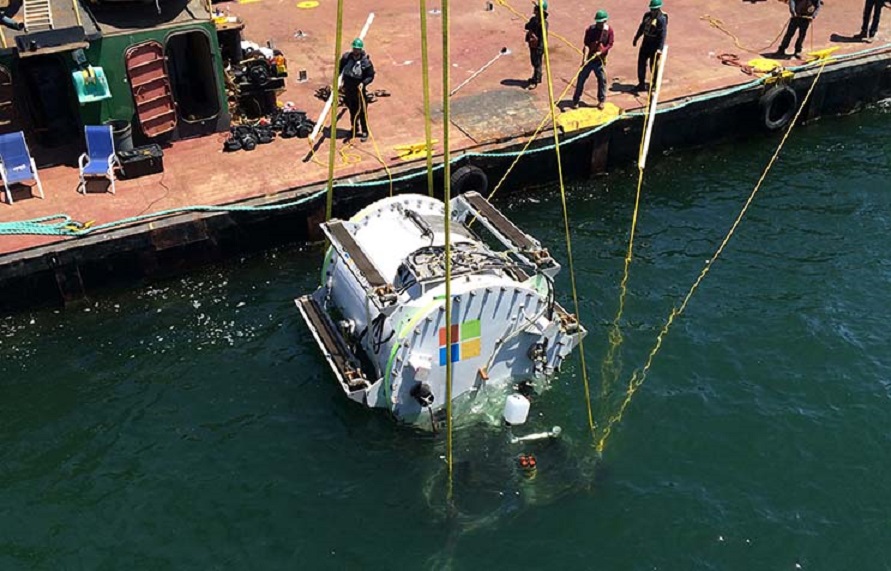A container packed with servers and positioned 36 meters underwater off Orkney, northern Scotland has been successfully recovered by Microsoft after a two-year trial. Dubbed as Project Natick, the underwater data centre (UWDC) is powered by a local grid which supplies energy from renewable (wind, solar and other experimental marine energy systems) sources. Project Natick has also proven that data centre can be located underwater along the coast to support the rapidly increasing demand for cloud-based web services by businesses and people who are predicted to grow from the current 7.7 billion to 9.7 billion people in the next 30 years. It is useful to mention that over half of the global population is located within about 120 miles of the coast and numerous industries have been set up in coastal areas.
There is also a comparable trend in the number of internet users worldwide up from 3.92 billion in 2018 to 4.13 billion in 2019. Similarly, the number of internet of things (IoT), a complex web of interconnected personal devices such as smartphones, smart domestic durables and appliances, the network of civil-military-economic-energy infrastructure, etc., around the world has grown to 22 billion at the end of 2018 and is projected to touch 50 billion by 2030.
Closely associated is the issue of transmission of data. It is estimated that nearly 90 per cent of the data transmission involves submarine cables which first made a debut in between England and France in 1850s. The submarine cable network has expanded rapidly and as of early 2020, there are approximately 406 submarine cables in service around the world. Furthermore, from a minuscule capacity of 10 words per minute in the 1850s, these submarine cables can transmit 40 gigabytes of data per strand of fibre and the carrying capacity can be expanded into the terabytes.
It is fair to assume that the future IoT would involve gigantic data (generated-shared) in zettabytes (ZB) and in the long run in yotobytes (YB), and stored in special central and compacted storage spaces called Data Centre. These would have racks of servers and transmit information to the wider internet service providers and users. For instance, the Microsoft Project Natick UWDC docking structure is 14.3 meters in length and 12.7 meters in width. It has 864 servers on 2 racks with a storage capacity of 27.6 petabytes (27,600 terabytes) which is “enough to store at least 5 million copies of Finding Nemo”.
The Data Centre is part of the digital infrastructure and needs hundreds of megawatts (MW) of power to run the servers, supporting systems such as monitoring equipment, lighting, etc. These generate enormous amounts of heat that can potentially degrade its efficiency, the operational life of the processor, and in extreme cases even destroying it. This necessitates cooling systems which can be energy guzzlers. It is likely that by 2025 Data Centers will consume nearly 33% of global electricity production and the cooling process could cost as much as an estimated US$ 1.4 billion in electricity. Furthermore, Data Centers are potential aggravators of climate change and according to a study, during 2010-2015 the global digital industry was responsible for 1.4% of global emissions.
A combination of carbon-negative and proximity to submarine cables/users has encouraged mega technology companies like Google and Microsoft to explore UWDC. In 2009, Google patented a “water-based data centre detailing a floating data centre, complete with an energy supply fed by a wind-powered cooling system and wave-powered generator system using seawater”. Digital service providers have an ever-increasing demand for bandwidth for streaming audio-video-photos and other data. Netflix, YouTube and Web-based media streaming, the three major users (as of September 2019) of global traffic take up nearly 34.1% of the traffic and are investing in submarine cable systems by directly setting up new networks.
At another level, UWDC attracts stringent underwater requirements of being ‘resistant to seismic activity, flooding, and other types of natural disasters’ and the design of the Data Centre should be such that it can be expanded. It should be efficient in terms of cost of operations as also close to a location that offers cheap power source to make it more affordable. Another important consideration for UWDC location is fibre networks which should be near the end-user to reduce latency.
In Singapore, Keppel Data Centres and Toll Group plan to install a floating data centre at the Loyang Offshore Supply Base. It is expected to be ‘environmentally-friendly and resource-efficient’ and would use seawater for cooling. It is particularly significant for Singapore, an island state, as it will ‘free up valuable land for other urban uses, making it a particularly attractive proposition for land-scarce cities’.
By all counts, the market trends with regard to UWDC are very promising. Besides Microsoft and Goggle, new projects by other digi-tech companies can be expected. They will, however, have to keep in mind that these have low-carbon-footprint, are in close vicinity to users, provide low-latency in connectivity for a high-quality experience as also do not impact on the underwater environment-ecology.
Title image courtesy:https://datacenterfrontier.com/microsofts-submarine
Disclaimer: The views and opinions expressed by the author do not necessarily reflect the views of the Government of India and Defence Research and Studies.
References:
1. “Microsoft: undersea datacentres at offshore wind farms could boost web for billions”, https://www.rechargenews.com/wind/microsoft-undersea-datacentres-at-offshore-wind-farms-could-boost-web-for-billions/2-1-875547 (accessed 16 October 2020).
2.“Growing at a slower pace, the world population is expected to reach 9.7 billion in 2050 and could peak at nearly 11 billion around 2100”, https://www.un.org/development/desa/en/news/population/world-population-prospects-2019.html (accessed 16 October 2020).
3.“Number of internet users worldwide from 2005 to 2019”, https://www.statista.com/statistics/273018/number-of-internet-users-worldwide/ (accessed 16 October 2020).
4.“Number of internet of things (IoT) connected devices worldwide in 2018, 2025 and 2030”, https://www.statista.com/statistics/802690/worldwide-connected-devices-by-access-technology/ (accessed 16 October 2020).
5.“Submarine Cable Frequently Asked Questions”, https://www2.telegeography.com/submarine-cable-faqs-frequently-asked-questions (accessed 16 October 2020).
6.“Submarine Cables and the Internet Age”, https://www.ufinet.com/submarine-cables-and-the-internet-age/ (accessed 16 October 2020).
7.“Microsoft’s undersea data center now has a webcam with fish swimming past 27.6 petabytes of data”, https://www.theverge.com/tldr/2018/8/9/17669936/microsoft-undersea-datacenter-webcam (accessed 16 October 2020).
8.“Total Consumer Power Consumption Forecast”, https://www.researchgate.net/publication/320225452_Total_Consumer_Power_Consumption_Forecast/link/59d5ee16aca2725954c78d15/download (accessed 16 October 2020).
9.“Underwater Data Centers”, https://theliquidgrid.com/2017/10/24/underwater-data-centers/ (accessed 16 October 2020).
10. “The Digital Industry Is Part of the Climate Change Problem”, https://disruptionhub.com/the-digital-industry-is-part-of-the-climate-change-problem/ (accessed 16 October 2020).
11.“Underwater Data Centers Market – Growth, Future Prospects & Competitive Analysis”, https://www.credenceresearch.com/report/underwater-data-centers-market (accessed 16 October 2020).
12.“How the Internet Spans the Globe”. https://cacm.acm.org/magazines/2020/1/241709-how-the-internet-spans-the-globe/fulltext (accessed 16 October 2020).
13.‘The Future of Data Centers”, https://www.cbinsights.com/research/future-of-data-centers/ (accessed 21 April 2020).
14. “How Important Is Location When Choosing a Data Center?”, https://www.datacenterknowledge.com/industry-perspectives/how-important-location-when-choosing-data-center (accessed 16 October 2020).
15. “Floating Data Centers to be Designed for Singapore” https://www.maritime-executive.com/article/floating-data-centers-to-be-designed-for-singapore (accessed 16 October 2020).







